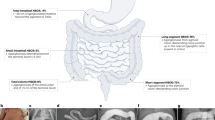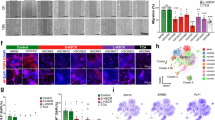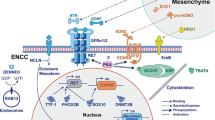Abstract
Hirschsprung's disease (HSCR), a congenital complex disorder of intestinal innervation, is often associated with other inherited syndromes. Identifying genes involved in syndromic HSCR cases will not only help understanding the specific underlying diseases, but it will also give an insight into the development of the most frequent isolated HSCR. The association between hydrocephalus and HSCR is not surprising as a large number of patients have been reported to show the same clinical association, most of them showing mutations in the L1CAM gene, encoding a neural adhesion molecule often involved in isolated X-linked hydrocephalus. L1 defects are believed to be necessary but not sufficient for the occurrence of the intestinal phenotype in syndromic cases. In this paper, we have carried out the molecular characterization of a patient affected with Hirschsprung's disease and X-linked hydrocephalus, with a de novo reciprocal balanced translocation t(3;17)(p12;q21). In particular, we have taken advantage of this chromosomal defect to gain access to the predisposing background possibly leading to Hirschsprung's disease. Detailed analysis of the RET and L1CAM genes, and molecular characterization of MYO18A and TIAF1, the genes involved in the balanced translocation, allowed us to identify, besides the L1 mutation c.2265delC, different additional factors related to RET-dependent and -independent pathways which may have contributed to the genesis of enteric phenotype in the present patient.
Similar content being viewed by others
Log in or create a free account to read this content
Gain free access to this article, as well as selected content from this journal and more on nature.com
or
References
Chakravarti A, Lyonnet S : Hirschsprung Disease; in: Scriver CR, Beaudet AL, Valle D, Sly WS, Childs B, Kinzler KW, Vogelstein B (eds): The Metabolic & Molecular Bases of Inherited Disease. New York: International Edition, McGraw-Hill, 2001, 8th edn, Vol IV. pp 6231–6255.
Amiel J, Lyonnet S : Hirschsprung disease, associated syndromes, and genetics: a review. J Med Genet 2001; 38: 729–739.
Mowat DR, Wilson MJ, Goossens M : Mowat-Wilson syndrome. J Med Genet 2003; 40: 305–310.
Brooks AS, Bertoli-Avella AM, Burzynski GM et al: Homozygous nonsense mutations in KIAA1279 are associated with malformations of the central and enteric nervous systems. Am J Hum Genet 2005; 77: 120–126.
Weller S, Gartner J : Genetic and clinical aspects of X-linked hydrocephalus (L1 disease): mutations in the L1CAM gene. Hum Mutat 2001; 18: 1–12.
Moore SW : The contribution of associated congenital anomalies in understanding Hirschsprung's disease. Pediatr Surg Int 2006; 22: 305–315.
Hofstra RM, Elfferich P, Osinga J et al: Hirschsprung disease and L1CAM: is the disturbed sex ratio caused by L1CAM mutations? J Med Genet 2002; 39: E11.
Parisi MA, Kapur RP, Neilson I et al: Hydrocephalus and intestinal aganglionosis: is L1CAM a modifier gene in Hirschsprung disease? Am J Med Genet 2002; 108: 51–56.
Okamoto N, Del Maestro R, Valero R et al: Hydrocephalus and Hirschsprung's disease with a mutation of L1CAM. J Hum Genet 2004; 49: 334–337.
Bocciardi R, Giorda R, Marigo V et al: Molecular characterization of a t(2;6) balanced translocation that is associated with a complex phenotype and leads to truncation of the TCBA1 gene. Hum Mutat 2005; 26: 426–436.
Lantieri F, Griseri P, Puppo F et al: Haplotypes of the human RET proto-oncogene associated with Hirschsprung disease in the Italian population derive from a single ancestral combination. Ann Hum Genet 2006; 70: 12–26.
Lantieri F, Griseri P, Ceccherini I : Molecular mechanisms of RET-induced Hirschsprung pathogenesis. Ann Med 2006; 38: 11–19.
Emison ES, McCallion AS, Kashuk CS et al: A common sex-dependent mutation in a RET enhancer underlies Hirschsprung disease risk. Nature 2005; 434: 857–863.
Yang CH, Szeliga J, Jordan J et al: Identification of the surfactant protein A receptor 210 as the unconventional myosin 18A. J Biol Chem 2005; 280: 34447–34457.
Chang NS, Mattison J, Cao H, Pratt N, Zhao Y, Lee C : Cloning and characterization of a novel transforming growth factor-beta1-induced TIAF1 protein that inhibits tumor necrosis factor cytotoxicity. Biochem Biophys Res Commun 1998; 253: 743–749.
Khera S, Chang NS : TIAF1 participates in the transforming growth factor beta1—mediated growth regulation. Ann NY Acad Sci 2003; 995: 11–21.
Schultz L, Khera S, Sleve D, Heath J, Chang NS : TIAF1 and p53 functionally interact in mediating apoptosis and silencing of TIAF1 abolishes nuclear translocation of serine 15-phosphorylated p53. DNA Cell Biol 2004; 23: 67–74.
Griseri P, Bachetti T, Puppo F et al: A common haplotype at the 5′ end of the RET proto-oncogene, overrepresented in Hirschsprung patients, is associated with reduced gene expression. Hum Mutat 2005; 25: 189–195.
Gabriel SB, Salomon R, Pelet A et al: Segregation at three loci explains familial and population risk in Hirschsprung disease. Nat Genet 2002; 31: 89–93.
Heanue TA, Pachnis V : Expression profiling the developing mammalian enteric nervous system identifies marker and candidate Hirschsprung disease genes. Proc Natl Acad Sci USA 2006; 103: 6919–6924.
Ikawa H, Kawano H, Takeda Y et al: Impaired expression of neural cell adhesion molecule L1 in the extrinsic nerve fibers in Hirschsprung's disease. J Pediatr Surg 1997; 32: 542–545.
Anderson RB, Turner KN, Nikonenko AG, Hemperly J, Schachner M, Young HM : The cell adhesion molecule l1 is required for chain migration of neural crest cells in the developing mouse gut. Gastroenterology 2006; 130: 1221–1232.
de Pontual L, Pelet A, Clement- Ziza M et al: Epistatic interactions with a common hypomorphic RET allele in syndromic Hirschsprung disease. Hum Mutat 2007; 8: 790–797.
Yim HE, Bae IS, Yoo KH, Hong YS, Lee JW : Genetic control of VEGF and TGF-beta1 gene polymorphisms in childhood urinary tract infection and vesicoureteral reflux. Pediatr Res 2007; 62: 183–187.
Jain S, Encinas M, Johnson Jr EM, Milbrandt J : Critical and distinct roles for key RET tyrosine docking sites in renal development. Genes Dev 2006; 20: 321–333.
Acknowledgements
The financial support of Italian Telethon (Grant GGP04257 to IC) is gratefully acknowledged.
Author information
Authors and Affiliations
Corresponding author
Additional information
Conflict of interests
None.
Rights and permissions
About this article
Cite this article
Griseri, P., Vos, Y., Giorda, R. et al. Complex pathogenesis of Hirschsprung's disease in a patient with hydrocephalus, vesico-ureteral reflux and a balanced translocation t(3;17)(p12;q11). Eur J Hum Genet 17, 483–490 (2009). https://doi.org/10.1038/ejhg.2008.191
Received:
Revised:
Accepted:
Published:
Issue date:
DOI: https://doi.org/10.1038/ejhg.2008.191
Keywords
This article is cited by
-
Hirschsprung’s disease: clinical dysmorphology, genes, micro-RNAs, and future perspectives
Pediatric Research (2017)
-
Self-aggregating TIAF1 in lung cancer progression
Translational Respiratory Medicine (2013)
-
TIAF1 self-aggregation in peritumor capsule formation, spontaneous activation of SMAD-responsive promoter in p53-deficient environment, and cell death
Cell Death & Disease (2012)
-
Novel association of severe neonatal encephalopathy and Hirschsprung disease in a male with a duplication at the Xq28 region
BMC Medical Genetics (2010)
-
TGF-β induces TIAF1 self-aggregation via type II receptor-independent signaling that leads to generation of amyloid β plaques in Alzheimer's disease
Cell Death & Disease (2010)



